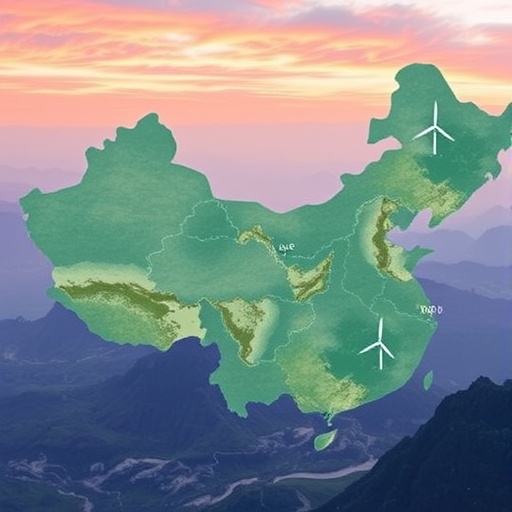The landscape of renewable energy production in China has witnessed a significant transformation as the nation strives to meet its ambitious climate goals and reduce its carbon footprint. Among the various sources of renewable energy, wind energy has emerged as one of the most promising alternatives. However, a recent study published in “Communications Earth & Environment” highlights an essential variable that influences the efficacy of wind energy generation: land use. Researchers Xu, Zhu, and Zhang have explored how different land use types affect the environmental benefits derived from wind energy farms across the vast terrains of China, shedding light on an often-overlooked aspect in the renewable energy discourse.
The study emphasizes that while wind energy production produces less greenhouse gas compared to fossil fuels, the impact of land use on the overall sustainability and ecological benefits of wind energy farms cannot be overlooked. Wind farms require substantial land, which raises questions regarding land competition, ecosystem disruption, and habitat loss. In their research, the authors applied an integrative approach that combined geographic information systems (GIS) along with environmental benefit assessments. This method facilitated a nuanced understanding of how various land use scenarios influence wind energy’s potential for ecological sustainability.
One critical finding from the research is the direct correlation between land use practices and the efficiency of wind energy farms. For instance, wind farms situated on agricultural lands may interfere with farming activities and reduce the efficiency of both wind energy production and agricultural output. In contrast, those constructed on degraded lands may enhance the environmental benefits, leading to improved biodiversity and ecosystem recovery. By identifying these relationships, the authors advocate for careful planning and management of land use around wind energy installations.
Moreover, the study puts forth a strong argument for integrating land use planning with energy policy frameworks. It encourages policymakers to consider ecological factors seriously when developing wind energy projects. This perspective is increasingly vital as countries around the globe, not just China, face dilemmas of land scarcity and competing land-use interests. Policymakers are called upon to adopt a holistic approach, which balances the urgent need for renewable energy with the necessity of conserving vital ecosystems.
The researchers also conducted a case study in specific regions of China where wind energy farms have been established. Their empirical analysis involved an assessment of wind farm locations concerning different types of land use. By examining these correlations, the study aims to provide actionable insights that can guide future wind energy projects. The findings suggest that areas with diverse land use—such as a mixture of forestry, agriculture, and natural habitats—can yield greater environmental benefits than monolithic wind farms developed on uniformly used land.
Another significant aspect examined in the research is the socio-economic implications of wind energy development. The local communities that live adjacent to wind farms are often affected by land use choices in various ways. From the potential for job creation through renewable energy jobs to disruptions caused by land appropriation for wind projects, local perspectives must be integrated into the planning process. The study calls for greater stakeholder engagement to ensure that the benefits of wind energy are equitably distributed and that local residents’ concerns regarding land use are adequately addressed.
In their pursuit of sustainable energy solutions, the authors stress the importance of ongoing research in the field of wind energy and land use. They advocate for interdisciplinary collaboration that encompasses ecology, renewable energy technologies, and social sciences. Only through a comprehensive understanding of how these domains intersect can we develop effective strategies that maximize the environmental benefits of wind energy while promoting social welfare.
One of the pressing concerns that arise from the findings is the urgent need for adaptive management practices. As climate conditions change and populations grow, the demands on land are bound to alter simultaneously. Implementing adaptive management strategies can help mitigate unforeseen consequences and facilitate the long-term sustainability of wind energy resources. The researchers suggest that integrating real-time data collection and analysis into management frameworks can bolster decision-making, enabling more responsive land use decisions.
Furthermore, the study contributes to the broader discourse on climate change mitigation strategies by reinforcing the need for comprehensive approaches that link renewable energy solutions with ecological health. In a time where the impacts of climate change are increasingly palpable, the researchers call for concerted efforts to re-evaluate land use policies that enable sustainable energy practices while safeguarding environmental integrity.
In conclusion, the work of Xu, Zhu, and Zhang offers valuable insights into a critical aspect of the renewable energy transition. By examining the interplay between land use and wind energy benefits, they underscore the necessity of nuanced, context-specific approaches to energy development. Their study serves as a significant reminder that achieving a sustainable energy future requires more than just technological advancements—it necessitates an integrated response that respects both our ecological systems and the communities that inhabit these landscapes.
The contributions made by this research into the intersection of land use and wind energy production could serve as a model for similar studies globally. As nations continue to grapple with energy demands and environmental pressures, the balance between renewable energy deployment and land stewardship will be increasingly crucial in guiding policy frameworks that shape our environmental future.
Modern society must aim to cultivate renewable energy sources while fostering biodiversity and managing land resources effectively. The detailed findings from this study provide a pathway for achieving this equilibrium, ensuring the advancement of wind energy without compromising the natural systems upon which we all rely.
Subject of Research: Impact of land use on the environmental benefits of wind energy farms in China.
Article Title: Land use impacts the environmental benefits of wind energy farms in China.
Article References: Xu, K., Zhu, H., Zhang, S. et al. Land use impacts the environmental benefits of wind energy farms in China. Commun Earth Environ 6, 905 (2025). https://doi.org/10.1038/s43247-025-02833-w
Image Credits: AI Generated
DOI: https://doi.org/10.1038/s43247-025-02833-w
Keywords: wind energy, land use, environmental benefits, renewable energy, biodiversity, ecosystem, sustainability, climate change.




